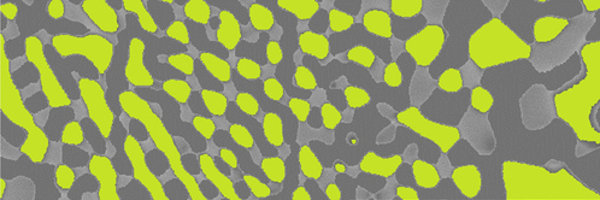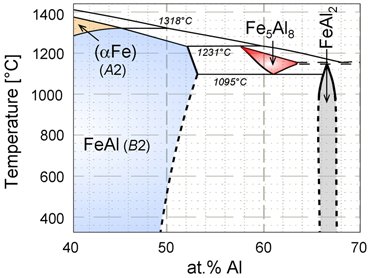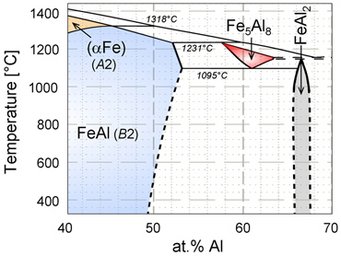
Lamellar Al-rich Fe-Al
Fe-Al alloys in the composition range up to 50 at.% Al with disordered A2 or ordered B2 or D03 crystal structure are intensively discussed in the literature as potential materials for structural applications at elevated and high temperatures especially due to their excellent corrosion resistance and low density compared to conventional steels.

Detail of the binary Fe-Al phase diagram showing the phase field of the high-temperature phase Fe5Al8 and the eutectoid decomposition into the phases FeAl + FeAl2.
These beneficial properties are an effect of the high Al additions, and a further increase of the Al content will result in an even better oxidation resistance and an additional reduction in density. At very high Al contents the intermetallic phases FeAl2, Fe5Al8, and FeAl3 are formed which due to their brittleness are unsuited for structural applications. In the intermediate composition range between about 50 and 65 at.% Al, a two-phase field composed of B2 FeAl and the triclinic phase FeAl2 exists (see figure). Alloys in this composition range undergo a eutectoid phase transition at 1095 °C during cooling from the melt, where the high-temperature phase Fe5Al8 (so-called ε phase) decomposes into a fine mixture of FeAl and FeAl2. Alloys with about 61 at.% Al show a fully lamellar microstructure with average lamellar widths below 1 µm, which has some similarity to the well-known γ-TiAl + Ti3Al lamellar microstructures.
The microstructures of these in situ composite materials were systematically varied via composition (Al content, ternary additions) and heat treatments and detailed investigations of the resulting mechanical properties were performed within this DFG-funded project in collaboration with the group of Martin Heilmaier from Karlsruhe Institute of Technology (KIT).
